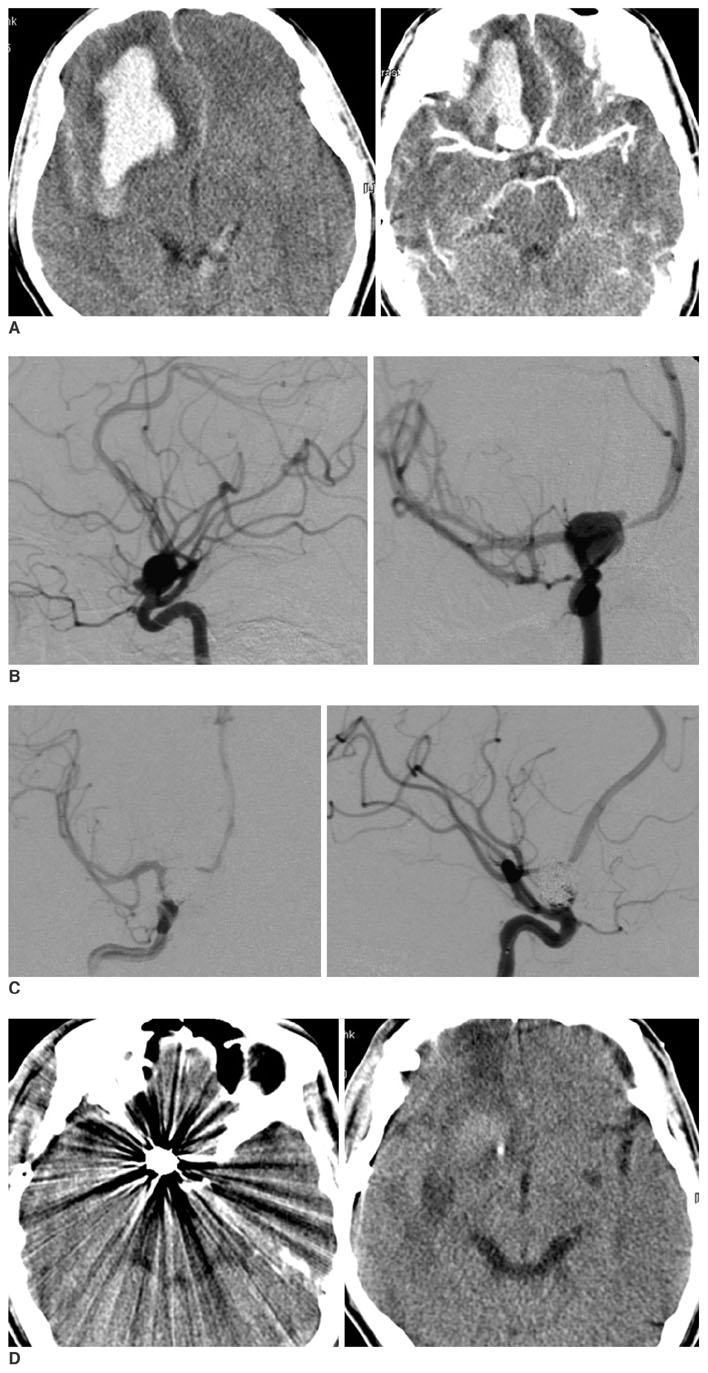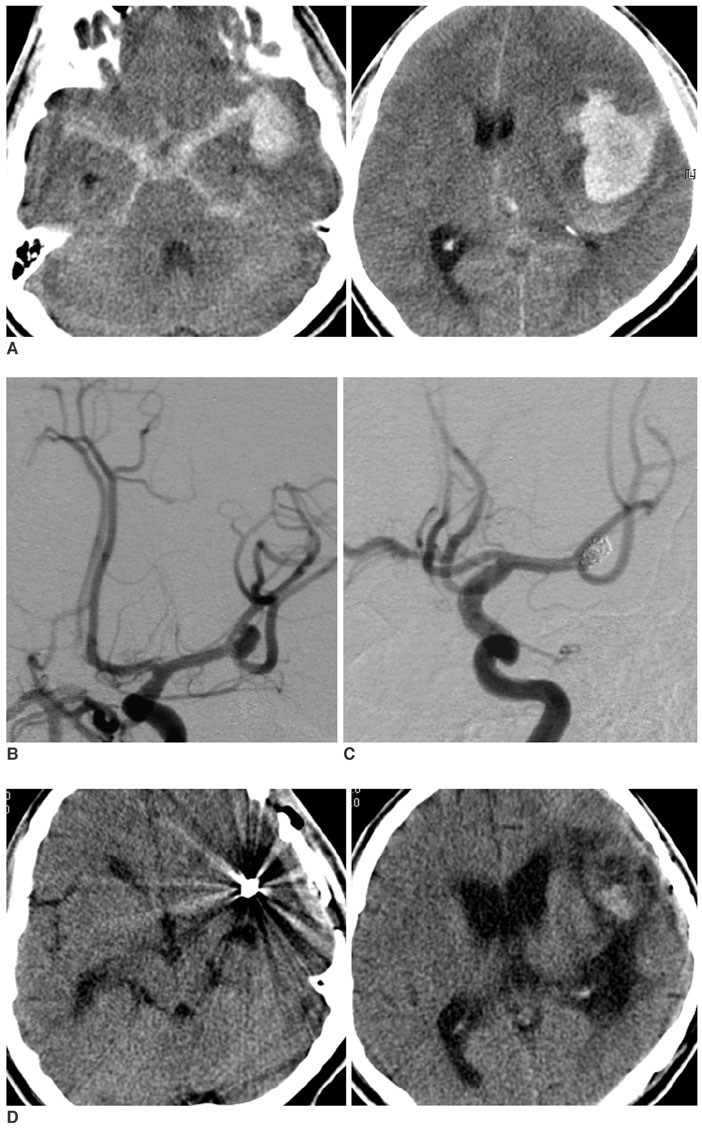Korean J Radiol.
2007 Feb;8(1):2-8. 10.3348/kjr.2007.8.1.2.
A Less Invasive Approach for Ruptured Aneurysm with Intracranial Hematoma: Coil Embolization Followed by Clot Evacuation
- Affiliations
-
- 1Department of Neurosurgery, Kyung-Hee University, College of Medicine, Seoul, Korea. neurokoh@hanmail.net
- 2Department of Diagnostic Radiology, Kyung-Hee University, College of Medicine, Seoul, Korea.
- KMID: 753859
- DOI: http://doi.org/10.3348/kjr.2007.8.1.2
Abstract
OBJECTIVE
The presence of an intracerebral hematoma from a ruptured aneurysm is a negative predictive factor and it is associated with high morbidity and mortality rates even though clot evacuation followed by the neck clipping is performed. Endovascular coil embolization is a useful alternative procedure to reduce the surgical morbidity and mortality rates. We report here on our experiences with the alternative option of endovascular coil placement followed by craniotomy for clot evacuation. MATERIALS AND METHODS: Among 312 patients who were admitted with intracerebral subarachnoid hemorrhage during the recent three years, 119 cases were treated via the endovascular approach. Nine cases were suspected to show aneurysmal intracerebral hemorrhage (ICH) on CT scan and they underwent emergency cerebral angiograms. We performed immediate coil embolization at the same session of angiographic examination, and this was followed by clot evacuation. RESULTS: Seven cases showed to have ruptured middle cerebral artery (MCA) aneurysms and two cases had internal carotid artery aneurysms. The clinical status on admission was Hunt-Hess grade (HHG) IV in seven patients and HHG III in two. Surgical evacuation of the clot was done immediately after the endovascular coil placement. The treatment results were a Glasgow Outcome Scale score of good recovery and moderate disability in six patients (66.7%). No mortality was recorded and no procedural morbidity was incurred by both the endovascular and direct craniotomy procedures. CONCLUSION: The results indicate that the coil embolization followed by clot evacuation for the patients with aneurysmal ICH may be a less invasive and quite a valuable alternative treatment for this patient group, and this warrants further investigation.
Keyword
MeSH Terms
Figure
Cited by 1 articles
-
A Less Invasive Strategy for Ruptured Cerebral Aneurysms with Intracerebral Hematomas: Endovascular Coil Embolization Followed by Stereotactic Aspiration of Hematomas Using Urokinase
Sang Heum Kim, Tae Gon Kim, Min Ho Kong
J Cerebrovasc Endovasc Neurosurg. 2017;19(2):81-91. doi: 10.7461/jcen.2017.19.2.81.
Reference
-
1. Abbed KM, Oglivy CS. Intracerebral hematoma from aneurysm rupture. Neurosurg Focus. 2003. 15:E4.2. Baltsavias GS, Byrne JV, Halsey J, Coley SC, Sohn MJ, Molyneux AJ. Effects of timing of coil embolization after aneurysmal subarachnoid hemorrhage on procedural morbidity and outcomes. Neurosurgery. 2000. 47:1320–1329.3. Birchall D, Khangure M, McAuliffe W, Apsimon H, Knuckey N. Endovascular management of acute subarachnoid haemorrhage in the elderly. Br J Neurosurg. 2001. 15:35–38.4. Byrne JV, Adams CB, Kerr RS. Endosaccular treatment of inoperable intracranial aneurysms with platinum coils. Br J Neurosurg. 1995. 9:585–592.5. Drake CG. Report of World Federation of Neurological Surgeons Committee on a universal subarachnoid hemorrhage grading scale. J Neurosurg. 1988. 68:985–986. (Letter).6. Gonzalez N, Murayama Y, Nien YL, Martin N, Frazee J, Duckwiler G, et al. Treatment of unruptured aneurysms with GDCs: clinical experience with 247 aneurysms. AJNR Am J Neuroradiol. 2004. 25:577–583.7. Hauerberg J, Eskesen V, Rosenorn J. The prognostic significance of intracerebral hematoma as shown on CT scanning after aneurysmal subarachnoid haemorrhage. Br J Neurosurg. 1994. 8:333–339.8. Heiskanen O, Poranen A, Kuurne T, Valltonen S, Kaste M. Acute surgery for intracerebral haematomas caused by rupture of an intracranial arterial aneurysm. A prospective randomized study. Acta Neurochir (Wien). 1988. 90:81–83.9. Niemann DB, Wills AD, Maartens NF, Kerr RS, Byrne JV, Molyneux AJ. Treatment of intracranial hematomas caused by aneurysm rupture: coil placement followed by clot evacuation. J Neurosurg. 2003. 99:843–847.10. Nowak G, Schwachenwald D, Schwachenwald R, Kehler U, Muller H, Arnold H. Intracerebral hematomas caused by aneurysm rupture. Experience with 67 cases. Neurosurg Rev. 1998. 21:5–9.11. Rowe JG, Molyneux AJ, Byrne JV, Renowden S, Aziz TZ. Endovascular treatment of intracranial aneurysms: a minimally invasive approach with advantages for elderly patients. Age Ageing. 1996. 25:372–376.12. Shimoda M, Oda S, Mamata Y, Tsugane R, Sato O. Surgical indications in patients with an intracerebral hemorrhage due to ruptured middle cerebral artery aneurysm. J Neurosurg. 1997. 87:170–175.13. Tokuda Y, Inagawa T, Katoh Y, Kumano K, Ohbayashi N, Yoshioka H. Intracerebral hematoma in patients with ruptured cerebral aneurysms. Surg Neurol. 1995. 43:272–277.14. Vinuela F, Duckwiler G, Mawad M. Guglielmi detachable coil embolization of acute intracranial aneurysm: perioperative anatomical and clinical outcome in 403 patients. J Neurosurg. 1997. 86:475–482.
- Full Text Links
- Actions
-
Cited
- CITED
-
- Close
- Share
- Similar articles
-
- Coil Embolization of Aneurysm Followed by Stereotactic Aspiration of Hematoma in a Patient with Anterior Communicating Artery Aneurysm Presenting with SAH and ICH
- A Less Invasive Strategy for Ruptured Cerebral Aneurysms with Intracerebral Hematomas: Endovascular Coil Embolization Followed by Stereotactic Aspiration of Hematomas Using Urokinase
- Spontaneous Occluded Anterior Communicating Artery Aneurysm during Coil Embolization Treated with One Coil Insertion into Remaining Stump
- Emergent Endovascular Treatment of Ruptured Dissecting Aneurysm of the Intradural Vertebral Artery Using a Self-Expandable Intracranial Stent and a Bioactive Hydrophilic coil
- Rebleeding of Ruptured Intracranial Aneurysms in the Immediate Postoperative Period after Coil Embolization



